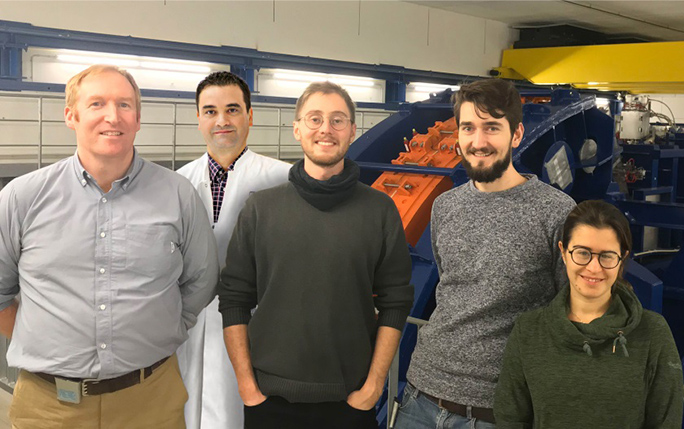Enhancing particle therapy accuracy

From left to right: Simon Jolly (UCL), Joao Seco (DKFZ), Laurent Kelleter (UCL), Lennart Volz (DKFZ) and Raffaella Radogna (UCL).
More than a month after the official end of the OMA project, the results keep having an impact. OMA fellow Laurent Kelleter managed to publish his theoretical work on the description of proton depth-light curves in plastic scintillator in the journal Medical Physics [1]. The model combines Bortfeld’s formula for a depth-dose curve with Birks’ formula for light quenching in scintillator. The resulting ‘quenched Bragg curve’ allows measuring the proton beam range and the light quenching (Birks’ constant) from a depth-light curve in a scintillator. The model is particularly valuable in the case of low spatial detector resolution. This is also the case for the range telescope developed by Laurent and his supervisor, Dr Simon Jolly, at University College London (UCL) for fast proton range quality assurance measurements.
Moreover, the range telescope has the potential to be used with therapeutic ion beams. A recent idea is to add a small fraction of helium ions to a carbon ion beam, with the aim of online treatment monitoring. At the same energy per nucleon, helium ions have about 3x the range of carbon ions, potentially enabling the simultaneous treatment (with carbon ions) and treatment monitoring (helium). A collaboration was set up between UCL and DKFZ (German Cancer Research Centre, Heidelberg, Germany) to explore the potential of a mixed helium/carbon beam in experiments with both plastic and anthropomorphic phantoms. The experiments were carried out at the Heidelberg Ion Beam Therapy centre (HIT). The residual rage of the helium ions exiting the phantom was measured with the UCL range telescope. The results were published in Physics in Medicine and Biology [2] and picked up by an article in Physics World [3].
[1] ‘A mathematical expression for depth‐light curves of therapeutic proton beams in a quenching scintillator‘, Laurent Kelleter and Simon Jolly (2020). Med. Phys. https://doi.org/10.1002/mp.14099
[2] 'Experimental exploration of a mixed helium/carbon beam for online treatment monitoring in carbon ion beam therapy', Lennart Volz, Laurent Kelleter, Stephan Brons, Lucas N Burigo, Christian Graeff, Nina Isabell Niebuhr, Raffaella Radogna, Stefan Scheloske, Christian Schömers, Simon Jolly and Joao Seco, Physics in Medicine & Biology 65(5) (2020), https://doi.org/10.1088/1361-6560/ab6e52
[3] ‘Mixed ion beams could enhance particle therapy accuracy’, Tami Freeman, 21 February 2020, Physics World, https://physicsworld.com/a/mixed-ion-beams-could-enhance-particle-therapy-accuracy/, Accessed on 2020-03-09.